DECEMBER 2012 AN IRRUPTION OF REDPOLLS
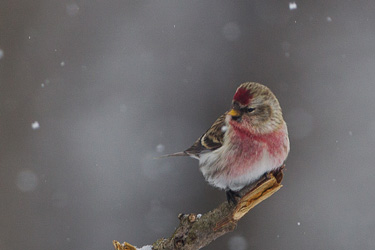
It is a happy year when Redpolls come south. They are a cheery, pink and red bird, and wear their red caps jauntily at the front, as if they were going to Kate’s royal wedding. Their flight is undulating, and they twitter and tweet.
2012 is one of those happy years. The Christmas Bird counts are mostly reporting over 500. Peterborough had 539, the highest in 20 years; Cobourg and Port Hope had 618, Huntsville had 408, Carden had 534 (they counted during perfect weather), Barrie had 565 (they did their count in the same windy weather that we did). Why did Algonquin Park only find 61, and Muskoka only 129 (they did their count at an earlier date, but also had bad weather)?
Orillia’s count had 519, but we were sure that there were a lot more, just hunkered down in the windy weather. But this is not a high for Orillia. In 1997 1411 birds were counted. 5 years out of the last 31 had no Redpolls on the Xmas bird counts.
The Common Redpolls breeding range in Ontario is north on the Hudson Bay lowlands, but also across the entire coastal North American Arctic (and also Eurasia). It is presumed that they irrupt south when there is a poor crop of catkins on birches and willows. It is postulated that an irruption indicates food shortage. Is this across the entire width of North America
or only one part of redpolls’ normal wintering area? Capture of a handful of banded redpolls even suggests that there is a general west-to-east movement of redpolls during an irruption. They can range as far south as the Mid Atlantic States.
Cornell University, using data from Feeder watch reports, has charted the extent of their spread, for many years and interesting charts of this can be seen on the web.
Redpolls are unlike typical winter migrants, because their wintering grounds can differ tremendously from one year to the next.
For example, tree sparrows are a common feeder bird every winter and so are considered migrants. Red Crossbills are considered nomadic, in that they move around their breeding range.
We are so lucky to be able to enjoy The Common Redpolls in 2012-2013.
Photos by Donald McDonald and Arni Stinnisen
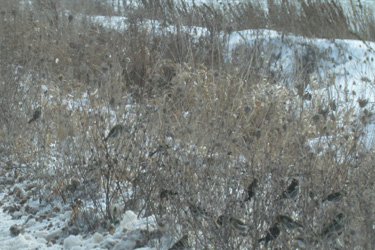
November 2012 Gray Dogwood – Cornus foemina spp racemosa
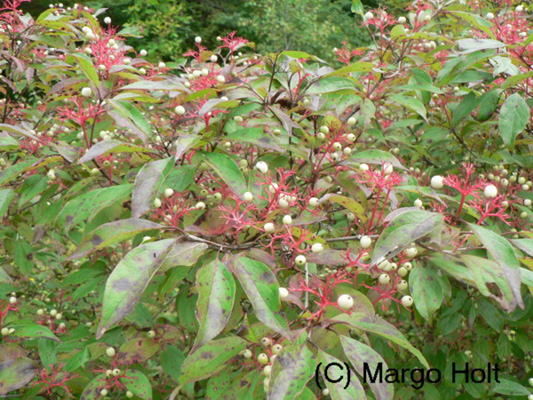
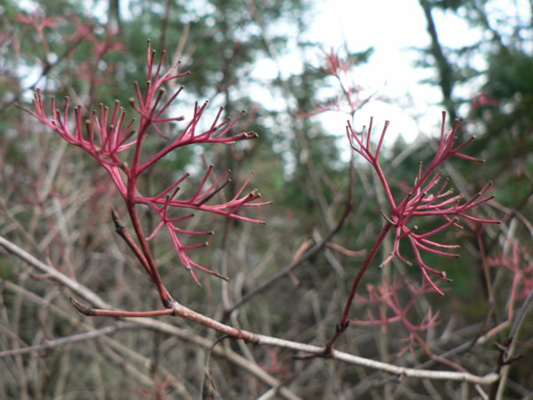
On a gray day in late autumn you are driving along Wylie Road in Carden.
There are very few birds. But among the tangled bank on the roadside, you may be cheered by bright red stalks in bright red clusters. This is Gray Dogwood (Cornus foemina ssp. racemosa). It is a common shrub along Wylie Rd. in Carden. In late autumn, even though it has lost its leaves and fruit, identification is made easy by the bright red stalks at the branch tips.
Although it is a common shrub in southern Ontario, it is particularly happy on limestone. You may also be cheered by another member of the Cornus family, Red osier Dogwood, a favourite of everybody
Photos by Margo Holt
October 2012 Multiclavula mucida
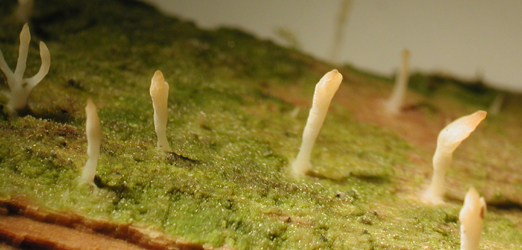
2 years ago, while visiting Victoria Bridge and the Black River on an ONC outing, we found Multiclavula mucida on a log, so this year during the ONC outing, I was anxious to see how it would fare in this year of the drought. It was not on the previous year’s log, which was very dry. A very water logged log is necessary.
Finally, after finding nothing, I relaxed on another log close to the river, until Wendy Hutchings asked me what all those little things were beside me. There were the little mushrooms, close to the river, so probably
this log had become more water soaked during the summer.
The algae appears as green granular scum on the surface where the mushroom fruits. As everyone knows, a lichen is made up of a mushroom and an alga. But not in this case, because it has been decided, that this association of fungi with algae does not give rise to a specialized thallus, or specialized structure. The algae obligately associated with (or required) by Multiclavula mucida appears as the green granular scum. These are ” obligate associates”, and are unable to live without each other.
So, is this one species or two?
Is a lichen one individual or 2 (or more)? Many fungi are obligate associates with certain trees, such as Tamaracks. So, does that make them one structure or two?
Many scientists over our lifetimes have classified species, but some just won’t go into the binders we have set up. ( See the Slime Mould Find of the Month –October 2009, for another obstinate group.)
Discussions of what is “it”, or is “it” an ecosystem, could last for days, including, what are we, the human body. What would Linnaeus say?
September 2012 ORGAN-PIPE MUD DAUBER WASP NEST (Trypoxylon politum)
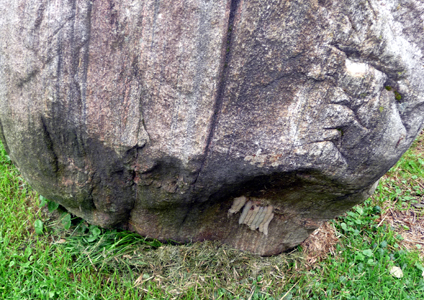
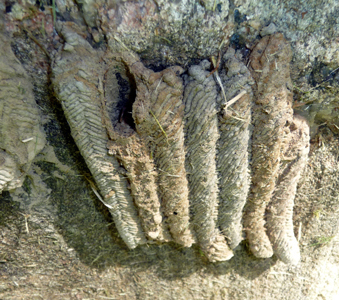
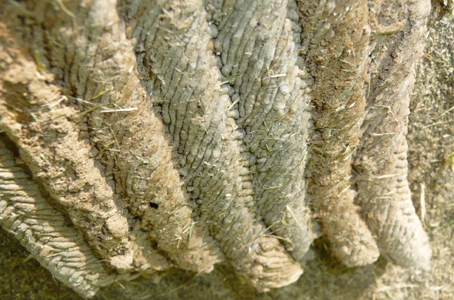
Dave Hawke found this Organ-Pipe Wasps nest on the side of a boulder in the parking lot of Grant’s Woods. Although it is said to be common, none of us (about 15 of us) has ever seen a nest before -nor did we see the wasp at this time.
Further investigation finds that Kyra Howes has one on her house, as has Paul Novosad. We have another report from Burke Korol of a nest, and wasp, he found at the Mayer’s marsh viewpoint/shelter on the North Simcoe Rail Trail on 6 August 2012.
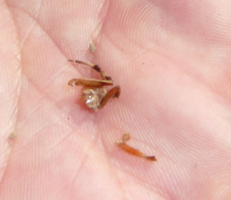
that we picked from the top of the broken tube
About 50% of the nests are built on buildings and about 30% built on rocks, but the nest must be near a site with soft clay/mud. The creek at Grant’s Woods may have been the source of the clay. The female rolls small bits of mud into a ball and adds it to the tube -a very labour intensive activity.
When the tube is large enough, she catches spiders, stings them to paralyze them, then stuffs them into the tube. She then lays an egg, seals the tube, and repeats this until there are several chambers in the several tubes .
Meanwhile, the male stands guard over the nest. When the larva hatches it eats the paralyzed, but living (fresh) spiders, then spins a cocoon,
and overwinters as a pupa. We will all be watching in the spring to see them chewing their way through the wall of the tube, then mating , we hope, and then starting other nests nearby.
EASTERN ( RED-SPOTTED ) NEWT August 2012
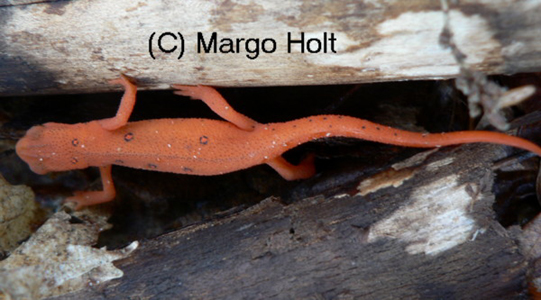
We found a Red Eft this August in North Simcoe County, in a mixed forest between 2 ponds.
The eastern newt or red-spotted newt (Notophthalmus viridescens) is a common salamander of eastern North America. Eastern Newts have three stages of life: (1:) the aquatic larvae which transform into (2:) the Red Eft or terrestrial juvenile stage, and (3:) the aquatic egg laying adult.
The Red Eft leaves the water to live on land.. They can travel unmolested during the day, because of the bright warning colour which shows that the skin secretes a poisonous substance, They live in wet forests near small lakes or ephemeral ponds.
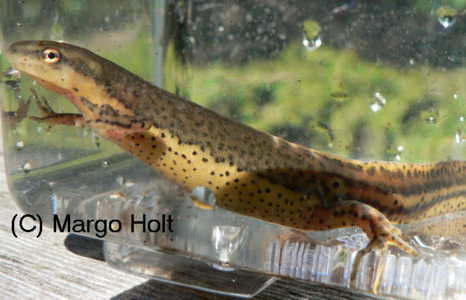
After several years they then transform to the adult newt. The photo shows the yellowish to green brown adult newt, with a scatter of black dots, and a series of larger black bordered red spots on the back. The belly is yellowish and covered with tiny black spots.
On October18/14, on a club outing, Leanore Wianko found the decomposing body of a small adult newt.
July 2012 Nesting Rock Bass
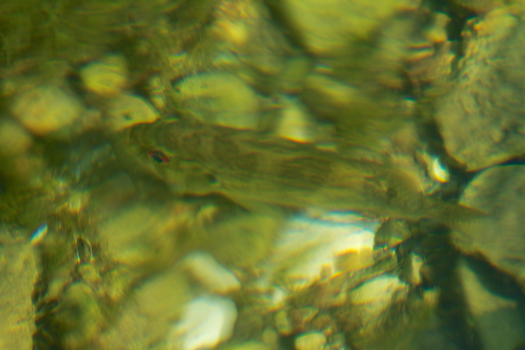
This photo by Arni Stinnissen shows the fish’s red eye and his ability to change his colour to match his surroundings, chameleon-like. When the sun shone he became patchy to match the surrounding rocks. The white rocks, which I presumed were the nest, are visible.
July 2012 has been hot and dry, not good for nature observations, especially not mushrooms). We have all become insect watchers. Fortunately, the fish seem to be unaffected by this weather.
So the find of the month for July is a rock bass on a nest. ( A photo of a captured Rock Bass, can be seen as F of the M on November 2010)
On the first of July I noticed a rock bass near my dock in Lake Couchiching, and it was still there an hour later. It seemed to be guarding an unobtrusive nest, on the bottom, in about a meter of water. It stayed over a few unremarkable stones, although the algae had been fanned away so they were whiter than the surrounding stones. It rarely moved the dorsal fin, but the pectoral and anal fins kept fanning. He (for it was a he) might suddenly go about half a meter away, after some unidentified threat, but when a crayfish came near he sent it scudding away, with vigour.
I found this interesting and checked him 3 or 4 times a day, while I relaxed on a chair on my dock. My poor lonely persistent fish kept guarding and fanning his nest until July 11, when he suddenly disappeared.
So, what happened? Maybe the females thought his nest was inadequate for their eggs, maybe there were no female Rock Bass in Lake Couchiching, or maybe it all happened while I watched and the eggs and hatchlings were too small for me to see.
I discussed this with Jeff Hathaway of Sensational Snakes, Orillia. He told me that he had a rock bass in his aquarium, guarding a nest, at the same time as mine in the lake. However, we know that, in the aquarium, there was no female there to lay her eggs. We don’t know what triggered the nest building and guarding in the 2 fish, one in nature, and one in an artificial environment.
Follow up: An aggressive male Rock Bass nested in the same location in 2013 and 2014, but not in 2015.
June 2012 Hummingbird Moths:
Hummingbird Clearwing: Hemaris thysbe
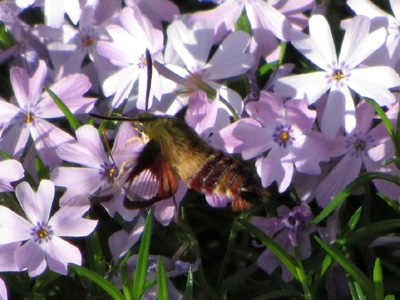
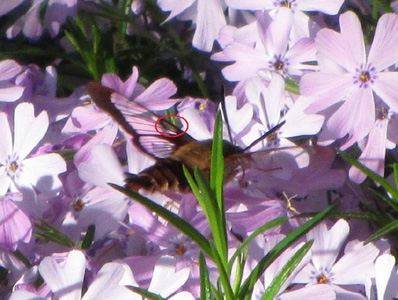
On May 26, several of us saw a Hummingbird Clearwing nectaring on dandelions, along Line 5 beside The Copeland Forest.
The same day another was reported by Barbara Taylor of Muskoka , on the Muskoka Bird Board. It was visiting in her garden. She took these excellent photos, which she has allowed us to use. Since then, in June, we have seen 2 more in Carden. They are not uncommon.
The photo on the left was taken by Margo Holt several years ago, with its tongue out, ready to nectar on Hoary Pocoon at the Wasaga Dunes Park.
Clearwing moths are day flying moths, which look like miniature hummingbirds, but are sometimes mistaken for bumblebees.
They hover rather than land, and on closer inspection, the clear wings are seen.
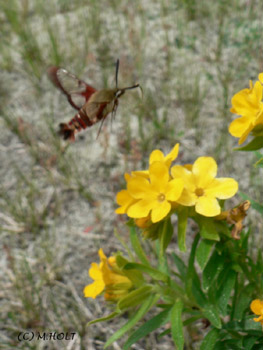 There are 3 types of Clearwings :
There are 3 types of Clearwings :
Hemaris thysbe or Hummingbird Clearwing
Hermaris diffinus or Snowberry Clearwing
Hemaris gracilis or Slender Clearwing ( our least common).
H. thysbe can always be told from other species of Hemaris by the row of dark scales bisecting the forewing discal cell (absent in other Hemaris species).
For more complete information Barbara has recommended:
Hemaris thysbe references:
http://www.entomology.ualberta.ca/searching_species_details.php?s=545
http://www.silkmoths.bizland.com/hthysbe.htm
http://www.butterfliesandmoths.org/species/Hemaris-thysbe
May 2012 Witches’ Broom
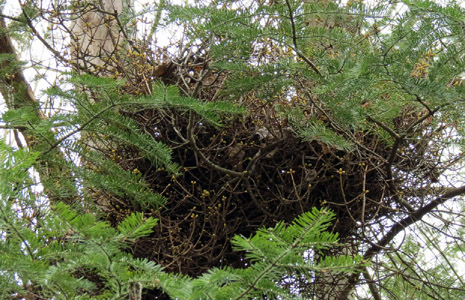
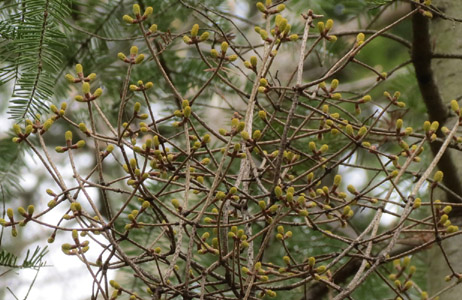
Early May growth form lasted about 2-3 weeks
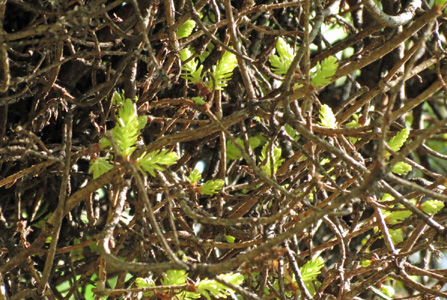
May 14: buds had opened up
If you are walking through the woods, and encounter something that at first sight looks like a squirrel’s nest, you might look more closely
and find it is a kind of dense bushy growth on balsam fir called a “witches’ broom”.
This brushy growth was found about 20 feet from the ground, on a path in Matchedash District ( Severn Township) and is caused by a rust : Melampsorella caryophyllacearum. This rust fungus is specific to Balsam Fir and has colonized the tissues of the tree and chemically induced it to produce the weird proliferation of branches. Many of the branches bear needles on which the aecia are found while many others, produced in previous years, are dead.
The rust blocks some of the hormones involved with light sensitivity, so that instead of growing symmetrically toward the light, branches and leaves (needles) grow thick and willy-nilly in any old direction, totally out of control. This is akin to the work of the devil. When the path to the life-giving force is blocked, development is out of control and, lacking access to life force, eventually followed by death.
The alternate hosts of these witches’ broom rusts are chickweeds and starworts, (members of the genera Cerastium and Stellaria of the family Caryophyllaceae). Witches’ brooms are also produced on spruces throughout their North American range, but are caused by species of rust, known as Chrysomyxa.
Photos by Heather Ewing; Information supplied By Dr Andrus Voitk ( formerly of Orillia, now in Newfoundland) and condensed by Nancy Ironside
April 2012 Mass Migration of Red Admiral Butterflies
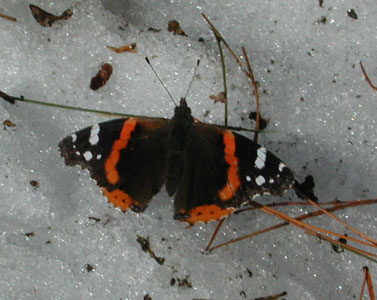
photo taken in Orillia April 8 /01 , basking on snow. photo by Nancy Ironside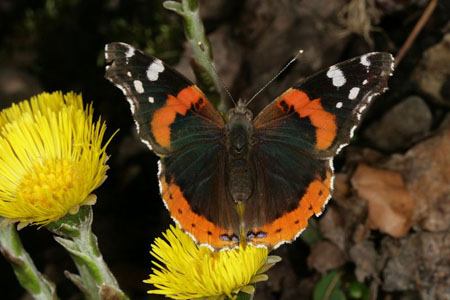
photo taken near Bracebridge April 16/ 12, nectaring on Coltsfoot
photo by Al Sinclair
The internet was abuzz with reports of beautiful, fresh Red Admiral butterflies, from most parts of southern Ontario and throughout northeastern North America.
The peak in our area was Monday, April 16th. Even “ordinary” people were noticing them. A hawk watch on Lake Erie counted about 140 going by per minute, and easily 5000 for the day. Radio and newspapers reported this phenomenon. A spectacular migration. Red Admiral butterflies are strongly migratory, coming up from the southern USA. Some years there are very few, and so very few are seen during the summer. Books comment on “ good migrant years” such as 1981, another of the migration of 1990.
One of the earliest April migrations occurred in 2001 on April 8th. 2010 was another good year.
Whether this year was the largest migration ever, as reported in several newspapers, is unknown. But certainly it was the most reported migration, since so many naturalists are connected to reporting sites. Butterfly people were in a reporting frenzy. We can expect to see many in the field this summer. They lay their eggs on Stinging Nettles –too bad these plants are not more common in butterfly gardens. After 2-3 broods they will
move southward in September or October.
Why is this migration so irregular? Several species of butterflies and dragonflies migrate, but only the Monarch is well studied. We don’t even know what we don’t know – a caution to those who try to interfere with nature.
March 2012 White Squirrel at Bayshore Village (on Lake Simcoe)
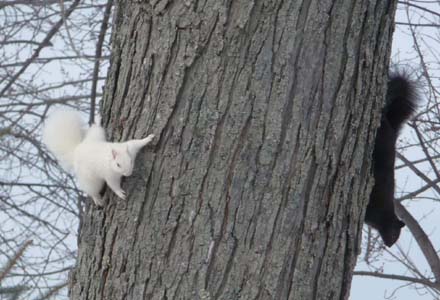
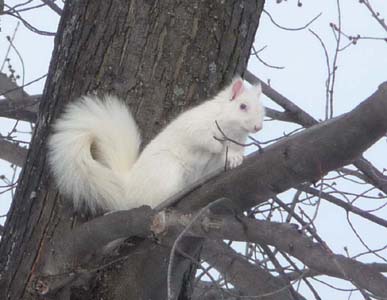
Wendy Hutchings and I were cruising for birds this winter, when she, to our surprise, noticed a white squirrel in a tree in Bayshore Village , south of Orillia on Lake Simcoe. Apparently it had no fear of people, as dog walkers came along and photographed this squirrel while we were there. Black squirrels ran when it chased them.
This was not an albino squirrel, which would have pink eyes, but a leucistic colour variation, since it had black eyes.
We found that a reporter for the Packet and Times had sighted a white squirrel in November 2010, in Bayshore Village but we are unable to find out if this was the earliest sighting, or if there were more than one in this population.
Most white squirrels in North America are genetic color variants of the gray species, not unlike the fairly common black squirrel. They breed normally and may have gray siblings. It is thought that the genes that normally produce a white underbelly in the gray squirrel are active in a wider area of their bodies, often leaving discernible gray patches on the spine and head. Does the white coloration provide some kind of survival advantage ?
Update: February 25/13 -at least one white squirrel is still there and seen to-day.
Exeter, in southern Ontario, appears to be the white squirrel capital of Ontario. They decorate their lamposts, garbage cans and retail stores on the main street, with the image of the white squirrel. They even have a yearly festival. I could find no estimate of the numbers there.
Photos and text by Nancy Ironside
February 2012 Stubble Lichens of Copeland Forest
This report and photos are from Troy McMullin, PhD., from University of Guelph , who did an inventory of the lichens of the Copeland forest for the Couchiching Conservancy in October.
See also report on Find of the Month December 2011
One of the most inconspicuous groups of lichen is the stubbles, or stubble lichen. This group is characterized by tiny stalks <1(-1.5) mm in height that have small pinhead-like expansions at the top. These stalks can appear similar to facial stubble when they are numerous, which is where their name is derived from. The stubbles are generally host specific; for example, many only live on one type of tree that is at a particular stage of development. This group is often used as a bioindicator of old forests with
little disturbance. A correlation has been found between the number of stubble species and the age of a forest, that is, the more species the older and less disturbed the forest. In the Copeland Forest, fourteen species were found, which is high. According to lichen researchers, the number of stubble lichens in the Copeland suggests it is a healthy mature forest,
but not yet an ‘ancient forest’ – a suiting description for a forest that was heavily logged, but seems to be recovering well. The following photos represent some of the stubble lichens found in the Copeland forest.
If you have not found stubble lichens, Troy offers these suggestions:
To spot stubble lichens, I start by looking for specific habitats and substrates where they are likely to occur. Next, I look for them with my eyes alone,
looking at branches and bark from a side profile and against the sky if possible. Once I spot stalks, I have a closer look with my hand lens to make sure they are indeed stubbles. Stubbles are sensitive to disturbance, therefore; it is best to look for them in the oldest and least disturbed forests as possible The thallus is usually in the bark or wood, along with the algae, but the fruiting bodies, which have no algae, grow out from the thallus.
The fruiting bodies can take a long time to develop, but once they appear they can last for several years. Stubbles, like most lichens, do not change throughout the year, so they can be spotted at any time. A good place to start looking for them is on large decorticated snags because stubbles commonly occur on them and the black stalks on pale lignum makes them stand out.
Orillia Astronomy Club has sent us this find of the month for January 2012
The supernova in M101
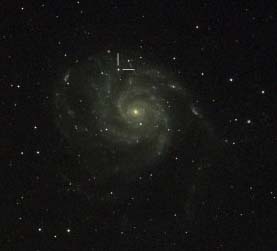
A supernova is a huge explosion of a large star (larger than our sun) at the end of its life when most of it’s fuel has been used up and the balance between gravity and the fusion reactions break down. The event is brighter than a billion suns and out shines all the other stars (billions of them)
in the galaxy. At the same time many of the elements heavier than Iron, such as gold and lead are created and this is the origin of these elements on earth so that we can say we are made up of star dust. We are seeing this supernova in M101 now, but it really happened 30 million years
ago, as this is how long it took the light to reach us.
M 101 is a galaxy like ours, about 30 million light years away ( 3x 10 to the 20th power, kilometres away) and is found just above the end of the handle of the big dipper. You can expect to see a supernova about every 300 years in a galaxy. We are due for one in ours, the Milky way galaxy.
The photo was taken by Steve Tate, of Barrie, of the recent supernova in M 101 ( it is marked by 2 white bars). The picture was taken at the Torrance Barrens.
Text by Gord Michener, President of the OAC and Past President of the ONC
